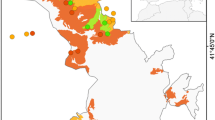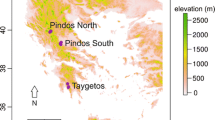Abstract
In order to preserve forest ecosystem services under climate change, site suitability for tree species has to be re-assessed and management strategies have to be developed to adapt species composition. Thereby, it is reasonable to consider information on both site suitability estimations based on current species distribution and also stand productivity determined by tree growth. Currently, models for species distribution (SDMs) and tree growth are used to investigate the response of tree species to climate. However, both approaches were only applied separately so far. In this study, SDMs and growth models for Picea abies, Fagus sylvatica, Abies alba and Pinus sylvestris were calculated based on the German national forest inventories. We asked whether there is a positive relation between a tree species’ occurrence and its growth and what can be learned by their joint interpretation. The two approaches resulted in different patterns with respect to the considered environmental variables. Tree growth and occurrence probabilities were not positively correlated. This may be explained by the influence of forest pathogens and competition on species distribution by means of an increase in mortality. We concluded that the consideration of demographic processes as drivers of species distribution improves the reliability of estimates for site suitability and additionally provides information on productivity.





Similar content being viewed by others
References
Albert M, Schmidt M (2010) Climate-sensitive modelling of site-productivity relationships for Norway spruce (Picea abies (L.) Karst.) and common beech (Fagus sylvatica L.). For Ecol Manag 259:739–749. doi:10.1016/j.foreco.2009.04.039
Albert M, Schmidt M (2012) Standort-Leistungs Modelle für die Entwicklung von waldbaulichen Anpassungsstrategien unter Klimawandel. Archiv f Forstwesen u Landschökol 46:57–71
Aussenac G (2002) Ecology and ecophysiology of circum-Mediterranean firs in the context of climate change. Ann For Sci 59:823–832. doi:10.1051/forest:2002080
Benito-Garzón M, Ruiz-Benito P, Zavala MA (2013) Interspecific differences in tree growth and mortality responses to environmental drivers determine potential species distributional limits in Iberian forests: including tree growth and mortality into species distribution. Glob Ecol Biogeogr 22:1141–1151. doi:10.1111/geb.12075
Brus DJ, Hengeveld GM, Walvoort DJJ et al (2012) Statistical mapping of tree species over Europe. Eur J For Res 131:145–157. doi:10.1007/s10342-011-0513-5
Carcaillet C, Muller SD (2005) Holocene tree-limit and distribution of Abies alba in the inner French Alps: anthropogenic or climatic changes? Boreas 34:468–476. doi:10.1080/03009480500231377
Charru M, Seynave I, Morneau F, Bontemps J-D (2010) Recent changes in forest productivity: an analysis of national forest inventory data for common beech (Fagus sylvatica L.) in north-eastern France. For Ecol Manag 260:864–874. doi:10.1016/j.foreco.2010.06.005
Dobbertin M (2005) Tree growth as indicator of tree vitality and of tree reaction to environmental stress: a review. Eur J For Res 124:319–333. doi:10.1007/s10342-005-0085-3
European Commission, Institute for Environment and Sustainability (European Commission. Joint Research Centre), European Soil Bureau, European Communities (2005) Soil atlas of Europe. European Communities, Luxembourg
Falk W, Mellert KH (2011) Species distribution models as a tool for forest management planning under climate change: risk evaluation of Abies alba in Bavaria. J Veg Sci 22:621–634. doi:10.1111/j.1654-1103.2011.01294.x
Gómez-Aparicio L, García-Valdés R, Ruiz-Benito P, Zavala MA (2011) Disentangling the relative importance of climate, size and competition on tree growth in Iberian forests: implications for forest management under global change. Glob Change Biol 17:2400–2414. doi:10.1111/j.1365-2486.2011.02421.x
Guisan A, Thuiller W (2005) Predicting species distribution: offering more than simple habitat models. Ecol Lett 8:993–1009. doi:10.1111/j.1461-0248.2005.00792.x
Guisan A, Edwards TC, Hastie T (2002) Generalized linear and generalized additive models in studies of species distributions: setting the scene. Ecol Model 157:89–100. doi:10.1016/S0304-3800(02)00204-1
Hanewinkel M, Hummel S, Albrecht A (2011) Assessing natural hazards in forestry for risk management: a review. Eur J For Res 130:329–351. doi:10.1007/s10342-010-0392-1
Hanewinkel M, Cullmann DA, Schelhaas M-J et al (2012) Climate change may cause severe loss in the economic value of European forest land. Nat Clim Change 3:203–207. doi:10.1038/nclimate1687
Hastie T (1992) Generalized additive models. In: Chambers JM, Hastie T (eds) Statistical models in S. Chapman & Hall/CRC. Fla, Boca Raton
Hastie T (2014) Gam: generalized additive models. R package version 1.09.1. http://CRAN.R-project.org/package=gam
Hiederer R (2013) European Commission, Joint Research Centre, Institute for Environment and Sustainability Mapping soil properties for Europe spatial representation of soil database attributes. Publications Office, Luxembourg
Hijmans RJ (2014) raster: geographic data analysis and modeling. R package version 2.3-0. http://CRAN.R-project.org/package=raster
Hijmans RJ, Cameron SE, Parra JL et al (2005) Very high resolution interpolated climate surfaces for global land areas. Int J Climatol 25:1965–1978. doi:10.1002/joc.1276
Hunger W (1986) Soil condition, nutrition and growth performance of Norway spruce (Picea abies [L.] Karst.) in fast-growing plantations. Fertil Res 10:243–250. doi:10.1007/BF01049354
Ilisson T, Metslaid M, Vodde F et al (2005) Storm disturbance in forest ecosystems in Estonia. Scand J For Res 20:88–93. doi:10.1080/14004080510041020
Iverson LR, Prasad AM (1998) Predicting abundance of 80 tree species following climate change in the eastern United States. Ecol Monogr 68:465. doi:10.2307/2657150
James JC, Grace J, Hoad SP (1994) Growth and photosynthesis of Pinus sylvestris at its altitudinal limit in Scotland. J Ecol 82:297. doi:10.2307/2261297
Jansen M (2008) Anpassungsstrategien für eine nachhaltige Waldbewirtschaftung unter sich wandelnden Klimabedingungen—Entwicklung eines Entscheidungsunterstützungssystems “Wald und Klimawandel” (DSS-WuK) Adaptation strategies for a sustainable forest management under climate change: development of a Decision Support System Forest and Climate Change (DSS-WuK). Forstarchiv. doi:10.4432/0300-4112-79-131
Johnstone D, Moore G, Tausz M, Nicolas M (2013) The measurement of plant vitality in landscape trees. Arboric J 35:18–27. doi:10.1080/03071375.2013.783746
Jump AS, Hunt JM, Peñuelas J (2006) Rapid climate change-related growth decline at the southern range edge of Fagus sylvatica. Glob Change Biol 12:2163–2174. doi:10.1111/j.1365-2486.2006.01250.x
Kölling C (2007) Klimahüllen für 27 Waldbaumarten. AFZ-DerWald 23:1242–1245
Kunstler G, Albert CH, Courbaud B et al (2011) Effects of competition on tree radial-growth vary in importance but not in intensity along climatic gradients. J Ecol 99:300–312. doi:10.1111/j.1365-2745.2010.01751.x
Lobo JM, Jiménez-Valverde A, Hortal J (2010) The uncertain nature of absences and their importance in species distribution modelling. Ecography 33:103–114. doi:10.1111/j.1600-0587.2009.06039.x
Mette T, Dolos K, Meinardus C, et al (2013) Climatic turning point for beech and oak under climate change in Central Europe. Ecosphere 4: art145. doi: 10.1890/ES13-00115.1
Millar CI, Stephenson NL, Stephens SL (2007) Climate change and forests of the future: managing in the face of uncertainty. Ecol Appl 17:2145–2151. doi:10.1890/06-1715.1
Morin X, Thuiller W (2009) Comparing niche- and process-based models to reduce prediction uncertainty in species range shifts under climate change. Ecology 90:1301–1313. doi:10.1890/08-0134.1
Nicoll BC, Gardiner BA, Rayner B, Peace AJ (2006) Anchorage of coniferous trees in relation to species, soil type, and rooting depth. Can J For Res 36:1871–1883. doi:10.1139/x06-072
Panagos P, Van Liedekerke M, Jones A, Montanarella L (2012) European Soil Data Centre: response to European policy support and public data requirements. Land Use Policy 29:329–338. doi:10.1016/j.landusepol.2011.07.003
Peng C (2000) From static biogeographical model to dynamic global vegetation model: a global perspective on modelling vegetation dynamics. Ecol Model 135:33–54. doi:10.1016/S0304-3800(00)00348-3
Polley H, Schmitz F, Hennig P, Kroiher F (2010) Germany. In: Tomppo E, Gschwantner T, Lawrence M, McRoberts RE (eds) National Forest Inventories—Pathways for Common Reporting. Springer, 233 Spring Street, New York, Ny 10013, United States, New York
Pretzsch H, Dursky J (2002) Growth reaction of Norway spruce (Picea abies (L.) Karst.) and European beech (Fagus silvatica L.) to possible climatic changes in Germany. A sensitivity study. Forstwiss Cent 121:145–154
Purves DW (2009) The demography of range boundaries versus range cores in eastern US tree species. Proc R Soc B Biol Sci 276:1477–1484. doi:10.1098/rspb.2008.1241
R Development Core Team (2012) R: A language and environment for statistical computing, reference index version 2.15.2. R Foundation for Statistical Computing, Vienna and Austria
Reidl K (2013) Landesanstalt für Umwelt, Messungen und Naturschutz Baden-Württemberg, Referat Boden, Altlasten, Forstliche Versuchs- und Forschungsanstalt Baden-Württemberg Potentielle Natürliche Vegetation von Baden-Württemberg. Verl. Regionalkultur, Ubstadt-Weiher
Rötzer T, Grote R, Pretzsch H (2005) Effects of environmental changes on the vitality of forest stands. Eur J For Res 124:349–362. doi:10.1007/s10342-005-0086-2
Scharnweber T, Manthey M, Criegee C et al (2011) Drought matters—declining precipitation influences growth of Fagus sylvatica L. and Quercus robur L. in north-eastern Germany. For Ecol Manag 262:947–961. doi:10.1016/j.foreco.2011.05.026
Svenning J-C, Skov F (2004) Limited filling of the potential range in European tree species: limited range filling in European trees. Ecol Lett 7:565–573. doi:10.1111/j.1461-0248.2004.00614.x
Sykes M, Prentice I, Cramer W (1996) A bioclimatic model for the potential distributions of north European tree species under present and future climates. J Biogeogr 23:203–233
Thomas CD, Cameron A, Green RE et al (2004) Extinction risk from climate change. Nature 427:145–148. doi:10.1038/nature02121
Thuiller W, Münkemüller T, Schiffers KH, et al (2014) Does probability of occurrence relate to population dynamics? Ecography n/a–n/a. doi: 10.1111/ecog.00836
Tinner W, Colombaroli D, Heiri O et al (2013) The past ecology of Abies alba provides new perspectives on future responses of silver fir forests to global warming. Ecol Monogr 83:419–439. doi:10.1890/12-2231.1
Tomppo EO, Schadauer K (2012) Harmonization of national forest inventories in Europe: advances under COST action E43. For Sci 58:191–200. doi:10.5849/forsci.10-091
Veloz SD, Williams JW, Blois JL et al (2012) No-analog climates and shifting realized niches during the late quaternary: implications for 21st-century predictions by species distribution models. Glob Change Biol 18:1698–1713. doi:10.1111/j.1365-2486.2011.02635.x
Wermelinger B (2004) Ecology and management of the spruce bark beetle Ips typographus—a review of recent research. For Ecol Manag 202:67–82
Wood SN (2011) Fast stable restricted maximum likelihood and marginal likelihood estimation of semiparametric generalized linear models. J R Stat Soc Ser B Stat Methodol 73:3–36. doi:10.1111/j.1467-9868.2010.00749.x
Wunder J, Reineking B, Bigler C, Bugmann H (2008) Predicting tree mortality from growth data: how virtual ecologists can help real ecologists. J Ecol 96:174–187
Acknowledgments
This study was funded by the Ministry of the Environment, Climate Protection and Energy Sector, Baden-Württemberg, Germany, within the research program KLIMOPASS 2014. The authors gratefully thank the Thünen Institute for providing access to the national forest inventory data as well as the European Soil Database and the WorldClim projects.
Author information
Authors and Affiliations
Corresponding author
Additional information
Communicated by Aaron R. Weiskittel.
Electronic supplementary material
Below is the link to the electronic supplementary material.
Rights and permissions
About this article
Cite this article
Dolos, K., Bauer, A. & Albrecht, S. Site suitability for tree species: Is there a positive relation between a tree species’ occurrence and its growth?. Eur J Forest Res 134, 609–621 (2015). https://doi.org/10.1007/s10342-015-0876-0
Received:
Revised:
Accepted:
Published:
Issue Date:
DOI: https://doi.org/10.1007/s10342-015-0876-0




